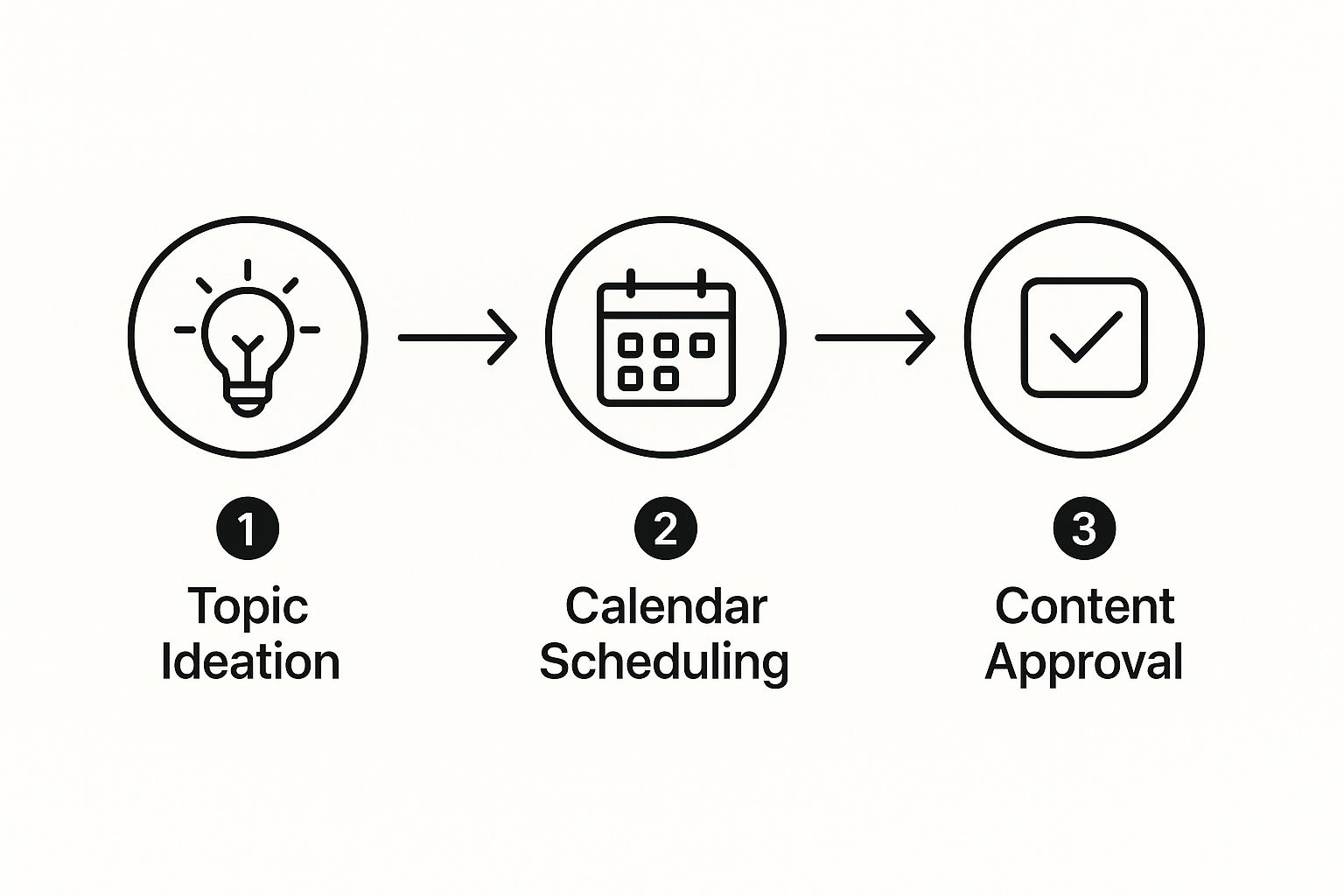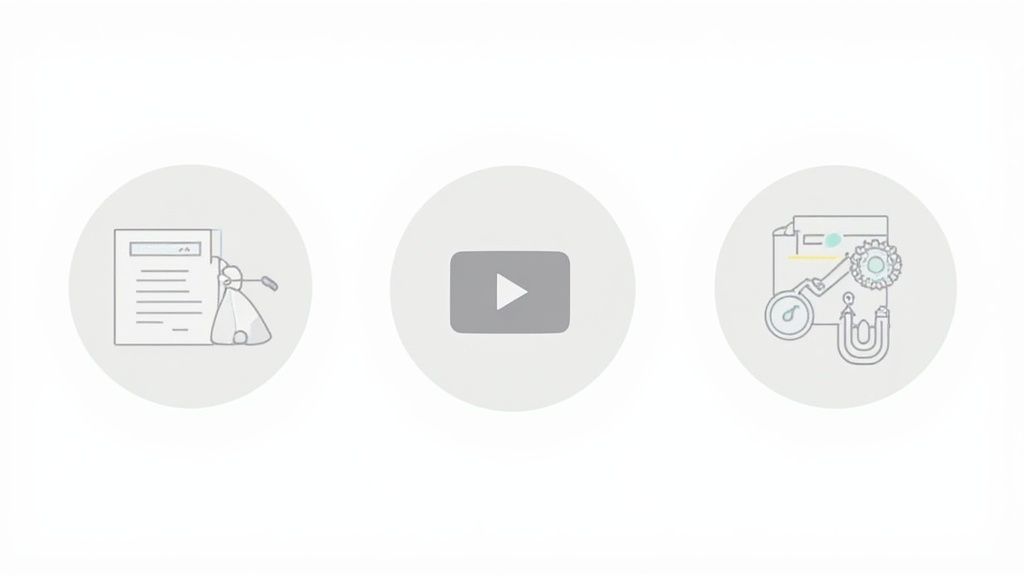A modern B2B marketing strategy isn't just about churning out blog posts. It’s about building a machine that creates and shares genuinely valuable content to pull in—and keep—a very specific audience. The end goal? Build real authority, get qualified leads, and nudge them toward becoming customers.
Why Your B2B Content Strategy Needs a Reboot
Let's be real, the old 'content is king' playbook is gathering dust on the shelf. B2B decision-makers today are swimming in an ocean of generic articles and won't give you the time of day unless you offer real, tangible value.
Firing off one-off campaigns and hoping for the best just doesn't work anymore. Your content has to do more than just exist; it needs to perform.
Today's B2B buyer is a research fanatic. They're self-sufficient, digging for information on their own terms and looking for educational content that actually helps them solve tough problems. This means we have to stop thinking of content as just another marketing task. It's a strategic company asset.
A modern B2B content strategy is really an integrated system. Its job is to educate prospects, give sales teams what they need to close deals, and ultimately, shorten the entire buying cycle.
Shifting From Campaigns to Ecosystems
A winning strategy isn't about isolated pieces of content. It's about building a connected ecosystem where everything—from a podcast episode to a deep-dive whitepaper—works together. Each piece guides a prospect along their journey.
This is how you build compounding value over time and cement your brand as the only one to listen to in your niche.
This kind of approach demands that marketing and sales are joined at the hip. Your content should tackle common sales objections head-on, answer the questions that pop up on every demo call, and provide air cover for your account execs. When content is tied directly to business goals, it stops being a cost center and becomes a serious revenue driver.
If you want to go deeper on this framework, you can check out our complete guide on building a successful B2B content marketing strategy.
Core Pillars of a Modern B2B Content Strategy
Building a resilient strategy that can handle whatever the market throws at it comes down to four fundamental pillars. These aren't just buzzwords; they are the bedrock of a content operation that delivers results.
Let's break down what really matters.
These pillars are the foundation. Nail these, and you're not just creating content; you're building a system for growth.
Content marketing is still the backbone of B2B. We know that 83% of B2B content is created specifically to build brand awareness and interest, proving its role in establishing thought leadership.
What's more, a whopping 84% of businesses now outsource their content creation. It's a clear sign that companies are turning to specialized experts to execute these complex, multi-faceted strategies effectively. You can find more stats like these over on Lead Forensics.
Decoding Your Audience and Their Journey

You can't create content that connects if you don't know who you're talking to. A winning b2b marketing content strategy is built on a deep, almost obsessive understanding of your audience. I’m not talking about job titles, but their real-world frustrations, professional goals, and the questions they're secretly typing into Google.
Generic personas stuffed with demographic data are a waste of time. We need to create living, breathing guides for every single piece of content we produce. The first, most critical step is mastering how to identify your target audience with surgical precision. Get this right, and everything else falls into place.
Moving Beyond Fictional Personas
Forget about inventing a persona named "Marketing Mary." Your time is much better spent gathering actual intelligence that reveals what your ideal customers truly think and say. This is where the gold is buried.
Here are a few of my go-to methods for digging it up:
- Mine Sales Call Recordings: Your sales team's calls are a goldmine. Seriously. Listen for the exact language prospects use when they describe their problems. What are their most common objections? What features get them excited?
- Run Targeted Customer Surveys: Don't just ask if they're satisfied. Ask pointed questions like, "What was the one problem you were trying to solve when you found us?" or "What piece of content would have helped you make a decision faster?"
- Host Sales & Marketing Workshops: Get your sales and marketing teams in a room together. The entire goal is to pull out the on-the-ground insights your sales reps hear every single day. For a truly effective strategy, this collaboration isn't optional.
The most powerful content ideas don't come from a brainstorm in a marketing meeting. They come directly from the mouths of your customers and prospects. Your job is to listen, document, and then create.
Mapping Content to the Buyer’s Journey
Once you really get who your audience is, you can start mapping their journey—from being a complete stranger to becoming a champion for your brand. A B2B buyer's journey is never a straight line; it’s a winding path with specific questions at every turn. Your content needs to provide the answers.
A classic pitfall is creating content without thinking about when a prospect needs it. A technical whitepaper is perfect for someone deep in the evaluation stage, but it's going to completely overwhelm someone just realizing they have a problem.
Let’s look at a practical example for a SaaS company selling project management software.
This kind of structure ensures you’re meeting buyers exactly where they are, providing value that builds trust at every single step.
An Example in Action
Let's say you've discovered through sales calls that a massive pain point for your prospects is migrating data from their old system. This is a huge point of friction in the decision stage.
Armed with that insight, you can create a specific, high-value piece of content: "The Ultimate Data Migration Checklist for Switching PM Tools."
This move is brilliant for two reasons:
- It directly addresses a known fear: You're showing them you understand their anxiety and already have a plan to solve it.
- It positions you as the expert guide: You aren't just selling software; you're providing a solution to a complex problem. That builds immense trust before they even sign up.
For your awareness-stage content, like a podcast, you could create an episode titled "Common Pitfalls of Inefficient Team Workflows" to grab the attention of those just starting their search. Tracking how these assets perform is crucial. Knowing the B2B podcast metrics you need to track will show you which topics are truly hitting home with your audience.
By deeply decoding your audience's journey and mapping your content to their specific needs, you'll transform your strategy from a scattergun approach into a precision-guided system that actually moves prospects forward.
Building Your B2B Content Creation Engine
Look, a killer B2B marketing content strategy is more than just a folder full of great ideas. It needs a powerful operational backbone to bring it all to life.
Fantastic content doesn’t just materialize out of thin air. It’s the direct result of a well-oiled machine built for consistency, quality, and eventually, scale. This is where you graduate from brainstorming sessions to building a genuine content creation engine.
The first move is structuring your team. There’s no single "right" answer here. The best fit comes down to your budget, your in-house talent, and how fast you need to move.
- In-House Team: This gives you the ultimate brand control and the deepest product knowledge. It's the way to go if content is a core business function, but be prepared—it requires a serious investment in salaries and ongoing training.
- Outsourced Model: Working with freelancers or a specialized agency like Fame gives you instant access to expert talent without the overhead. This is perfect for companies that need specific skills (like podcast production) or want to ramp up content creation quickly.
- Hybrid Approach: Many businesses strike a great balance with a small in-house team (maybe just a content strategist) who manages a roster of freelance writers, designers, and other specialists. This blends control with much-needed flexibility.
No matter which model you choose, your success will hinge on having crystal-clear processes. This is where so many content strategies fall apart—not from a lack of ideas, but from a complete lack of operational discipline.
From Ideation to Publication: A Clear Workflow
A documented workflow is your single source of truth. It kills the guesswork, smashes through bottlenecks, and ensures everyone on the team knows exactly what they need to do and when. A simple, repeatable process is your ticket to producing quality content, consistently.
This infographic breaks down a basic but incredibly effective workflow for taking a raw idea all the way to a published asset.

This visual guide—moving from topic ideation to calendar scheduling and on to final content approval—creates an accountable path for every single piece of content you produce. It turns chaos into a predictable system.
You’ll also want to create a brand style guide that dictates your tone, voice, grammar rules, and formatting. This ensures every piece of content feels like it came from your brand, no matter who actually created it.
Adopting the Pillar and Cluster Model
To really squeeze every drop of ROI from your content, you have to think bigger than just one-off blog posts. This is where the pillar-and-cluster model comes in. It's a game-changing framework for getting the most value out of every major content investment.
The concept is surprisingly simple:
- Create a Pillar Post: This is a huge, substantial piece of content covering a broad topic that's core to your business. Think of it as a comprehensive guide, an original research report, or an in-depth webinar.
- Create Cluster Content: Next, you "atomize" that pillar asset into dozens of smaller, related pieces. These "clusters" all link back to the main pillar page, creating a powerful web of internal links that screams topical authority to search engines.
A single webinar can be repurposed into ten blog posts, twenty social media clips, a series of email newsletter insights, and a guest post for a partner. This isn't about creating more work; it's about working smarter and extending the life of your best ideas.
For example, a pillar post on "The Complete Guide to B2B Lead Generation" could easily spawn cluster content like:
- A blog post on "5 Common Lead-Gen Mistakes to Avoid"
- An infographic showing the latest lead generation statistics
- A podcast episode interviewing a lead-gen expert
- A short video for LinkedIn on "How to Qualify Leads Faster"
This approach builds serious SEO authority and gives you a steady stream of content for all your distribution channels. It’s a true cornerstone of an efficient and effective B2B marketing content strategy.
And this strategic approach is catching on for a reason: it gets results. In fact, 49% of B2B marketers now say content marketing is their most effective channel for driving actual revenue. What's more, 76% of B2B companies now have dedicated content teams, proving the shift toward structured content operations is real. Even a foundational tactic like blogging shows immense power, with businesses that blog seeing 55% more website visitors. You can explore more data on these trends and discover additional insights about the impact of content.
Weaving Podcasts Into Your Content Strategy

While most B2B content strategies are built on the solid ground of blogs and whitepapers, many leave a high-impact audio channel sitting on the sidelines. I'm talking about podcasting. It’s a uniquely powerful way to build real authority and forge genuine connections, moving beyond the screen to become a voice in your audience's ear.
In the B2B world, the magic of podcasting isn't about entertainment. It's about intimacy and expertise, delivered at scale. Just think about it. When a key decision-maker subscribes to your show, they're inviting your brand’s experts and your ideas into their commute, their gym session, or their workday. That creates a level of trust and familiarity a blog post just can't match.
Finding Your Angle and Format
Your first step isn't buying a fancy microphone; it's finding your strategic opening. Honestly, the world doesn’t need another generic marketing podcast. Your show needs a razor-sharp, specific angle that serves a tightly-defined niche. Are you the go-to resource for CFOs in the fintech space? Or maybe for HR leaders navigating the complexities of the manufacturing sector? Get specific.
Once your niche is crystal clear, you can lock in the show's format. Each style offers distinct advantages for your b2b marketing content strategy:
- Interview-Based Shows: These are fantastic for networking and borrowing authority. When you invite influential guests, you not only bring fresh expertise to your audience but also get a warm introduction to their network when they share the episode.
- Solo Insight Shows: This format is all about positioning your in-house experts as the thought leaders. It's a direct line to share your company's unique point of view and build a loyal following around a specific personality or philosophy.
- Panel Discussions: Want to create some energy? A panel format can spark dynamic, engaging conversations by bringing multiple perspectives together to hash out a single topic. It’s a great way to showcase a comprehensive, lively understanding of complex industry issues.
Your podcast's format should be a direct reflection of your strategic goals. If you're chasing rapid audience growth and want to network like crazy, an interview show is your best bet. If you're looking to cement your brand's proprietary framework, a solo show will be far more effective.
Sourcing the right guests is a strategic game in itself. I always look for people who not only have deep expertise but also bring an engaged audience of their own. A guest from a complementary, non-competing business can open the door to some incredibly valuable cross-promotional partnerships.
Turning Episodes Into a Content Machine
Here’s where so many people go wrong: they treat a podcast episode as a one-and-done asset. The real power comes from seeing each episode as the sun in its own content solar system. This "repurposing" mindset is absolutely crucial for maximizing your ROI and is the cornerstone of any efficient content strategy.
A single 30-minute episode can be methodically broken down into a whole fleet of other assets. This is how you feed your entire marketing engine for weeks off a single recording session, turning it into a sustainable content flywheel.
Here's a simple breakdown of how that looks in practice:
- Full Episode Transcript: Get the full transcript up on your blog. This immediately creates a long-form, SEO-rich article that search engines can easily index.
- SEO-Driven Show Notes: Create a dedicated page for every episode with detailed show notes. You'll want to include key takeaways, guest bios, and links to all the resources mentioned. This becomes a go-to hub for your listeners.
- Quote Cards & Audiograms: Pull the most punchy, insightful quotes from the episode and turn them into shareable graphics for social media. Even better, create short audiograms—those little audio snippets with a waveform visual—which are absolute gold on platforms like LinkedIn.
- Blog Post Spinoffs: Don't just post the transcript. Zero in on a key theme from the conversation and write a dedicated blog post that dives deeper, embedding the full podcast episode right inside the article.
This approach ensures you're squeezing every last drop of value from your hard work. For anyone serious about mastering this, exploring a comprehensive course on podcasting can give you the structured knowledge to launch and scale a show that truly delivers.
By integrating podcasting this way, it stops being "just another channel" and becomes a central pillar of your entire b2b marketing content strategy.
Mastering Content Distribution and Promotion

Let's be honest. Creating a brilliant piece of content and then doing nothing to promote it is like hosting an epic party and forgetting to send the invitations. All that work, straight down the drain, because nobody showed up.
An effective B2B marketing content strategy treats distribution with the same respect and rigor as creation. The old "if you build it, they will come" fantasy is a one-way ticket to zero traffic and even less ROI.
Your content needs a real, multi-channel plan to get in front of the right decision-makers exactly when they're looking for solutions. This is so much more than just dropping a link on your LinkedIn profile and calling it a day.
Architecting Your Distribution Framework
Think of your distribution channels like an investment portfolio. You need to diversify across owned, earned, and paid media to get the best results. Each one plays a unique role.
- Owned Media: This is your home turf—the channels you control. Think company blog, email newsletter, and your podcast feed. These are foundational for building a direct line to your audience and nurturing those relationships.
- Earned Media: This is the digital word-of-mouth you can't buy. It’s guest posts, mentions from industry players, and organic shares. Earned media is pure gold for building credibility.
- Paid Media: This is your pay-to-play option. Targeted LinkedIn ads, sponsored content, search ads—you name it. Paid is fantastic for getting in front of a specific, new audience, fast.
The magic happens when you blend all three. You might promote a new pillar post (owned) with a targeted LinkedIn campaign (paid), which then gets picked up by an industry expert (earned). That’s how you build real momentum.
Distribution isn't an afterthought. It's something you must plan from the very start. Before you write a single word, ask yourself: "How will we get this in front of 1,000 of our ideal customers?"
Using Social And Email The Smart Way
Just dropping links into your social feeds is lazy marketing. It doesn't work. Each platform has its own language.
On LinkedIn, for example, a long-form text post that tells a story or shares a strong opinion will almost always crush a simple link preview. Pull out a juicy insight from your content and use that as the hook.
This is critical because social media isn't going anywhere. By 2025, 97% of B2B marketers will have content as a core part of their strategy, and 90% point to social media as their top distribution channel. LinkedIn is still king, with 84% of marketers saying it delivers the best value.
Email is still one of your most powerful tools because you own that relationship. So don't just send a generic "new blog post is live" email. Segment your list and get personal.
- For Prospects: Frame your content as the answer to a specific pain point you know they're struggling with.
- For Customers: Share something that helps them get more value from your product, proving they made the right choice.
Activate Your Internal Army
One of the most overlooked distribution assets in any company is its own team. Your employees, especially in sales and customer success, have networks packed with potential customers and partners.
An employee advocacy program is a simple way to make it easy for your team to share company content. Give them pre-written social posts, key takeaways, and sharp graphics. A post from a trusted person carries so much more weight than one from a faceless brand page.
Finally, remember that different formats need different tactics. For a podcast, distribution has its own playbook. Learning how to promote a podcast means getting into podcast directories, leveraging your guests' audiences, and creating shareable audiograms for social.
Master these different techniques, and you’ll ensure every piece of content you create actually gets seen and makes an impact.
Measuring Performance and Proving ROI
Hitting "publish" on a piece of content isn't the finish line. It's the starting gun. Now comes the part that really matters: connecting all that hard work to what the C-suite actually cares about—revenue. It’s time to move beyond fuzzy analytics and prove your content's worth in cold, hard cash.
Too many marketers fall into the trap of reporting on vanity metrics. Sure, page views and social media likes are nice to see, but they won’t get next year's budget signed off. To show real ROI, we need to stop measuring attention and start measuring action.
Shifting Focus to Revenue-Centric Metrics
To prove your value, your reporting has to speak the language of sales and finance. This means tracking how your content actually influences someone's journey from a curious visitor to a paying customer. It's time to ditch the generic dashboards and get granular.
Here are the metrics that actually move the needle:
- Conversion Rates on Gated Assets: What percentage of people who land on your eBook page actually download it? This tells you how compelling your offer really is.
- Content-Sourced Leads: How many new names entered your CRM directly because of a content piece, like a webinar signup or a whitepaper download?
- Lead Quality by Asset: Are the leads from your "Ultimate Guide" better qualified than those from your "Beginner's Checklist"? Knowing this helps you create more of what attracts your ideal buyers.
- Pipeline Influence: This one is a game-changer. What percentage of your current sales pipeline has touched one or more of your content assets? A high number here is undeniable proof that content is essential for nurturing deals.
The most powerful shift you can make is from reporting on content activity to reporting on content impact. You'll go from saying, "Our blog got 10,000 views," to "Our blog generated 50 qualified leads, influencing $200,000 in our sales pipeline last quarter."
Tools and Tactics for Accurate Tracking
Connecting content to revenue isn't magic; it's about having the right technical plumbing in place. Without it, you’re just guessing. The goal is to create a clean data trail from the first blog post a prospect reads all the way to a closed-won deal in your CRM.
Your tracking toolkit should absolutely include:
- UTM Parameters: These are completely non-negotiable. Slap unique UTM codes on every single link you share. This is how you'll see in Google Analytics exactly which email, social post, or ad is driving traffic and, more importantly, conversions.
- Google Analytics Goals: Turn simple website visits into measurable outcomes. Set up specific goals for key actions, like form fills for your gated content or demo requests from a CTA on your blog.
- CRM Integration: This is where it all comes together. When your marketing automation tool (like HubSpot or Marketo) talks to your CRM (like Salesforce), you get a complete picture. You can see every single content touchpoint a lead had before and after they became a sales opportunity.
For instance, your CRM can reveal that a new $50,000 deal actually began six months ago when the prospect downloaded a case study. Then, they attended a webinar three months later and read a few blog posts before finally booking a demo. That’s how you prove pipeline influence with undeniable data.
This is especially true for assets like podcasts, where understanding engagement is critical. We've actually written a much deeper guide on how to measure podcast PR effectiveness that applies these same principles to audio content.
When you implement this level of tracking, your content shifts from being a creative expense to a predictable, revenue-generating engine. This data-backed approach not only validates your current b2b marketing content strategy but also gives you the hard evidence you need to secure more resources and keep growing.
At Fame, we help B2B companies build authority and drive revenue with strategic podcasting. Our end-to-end production services turn your expertise into a powerful content engine that generates a qualified pipeline. Learn how Fame can transform your B2B marketing.

